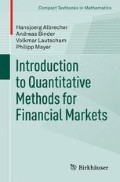Abstract
In Chapter 1, bonds have been introduced as an important class of financial assets which is structurally similar to loans. The authorized issuer promises in the bond contract to make future payments according to a fixed schedule, up to some final time T (the term or maturity of the bond).
Access this chapter
Tax calculation will be finalised at checkout
Purchases are for personal use only
Notes
- 1.
Due to their fixed payment schedule, bonds are also referred to as fixed income products.
- 2.
A stock company is required by law to hold Annual General Meetings where past and future activities are discussed, fiscal information is reviewed and the Board of Directors is elected.
- 3.
Larger strategic holdings by long-term investors are not counted into the free float, together with government holdings or holdings of founding investors.
- 4.
Stock prices of otherwise comparable companies with only a small free float can be more volatile. Some hedge funds had to experience this in 2008, as they lost more than 20bn GBP when closing short positions on Volkswagen stocks. Porsche had just announced that it had acquired as much as 74% of Volkswagen stocks. Only a relatively small portion of stocks was still free-floating, so that prices sky-rocketed within hours due to the sudden demand from hedge funds and the limited supply.
- 5.
Which currency in a traded pair is quoted as base currency is mostly based on historical convention.
- 6.
Source: www.bundesbank.de
- 7.
Note that the underlying of a derivative contract can again be a derivative with respect to another underlying, and so on.
- 8.
In our above example, the hedging portfolio consists of one FX forward contract.
- 9.
Note that we often take views when making financial decisions. For example, when part-financing the purchase of a house through a bank loan, the borrower might be able to choose between fixed or floating interest rates, or to fix an upper interest rate limit (also: cap) in the case of floating interest rates. It also used to be popular to finance real estate by loans in foreign currencies with lower borrowing rates, for instance, financing a German house with a CHF loan when interest rates in CHF were lower than in EUR. During the economic downturn starting in 2007, however, the CHF greatly appreciated in value against the EUR, so that CHF-denominated liabilities required a significantly higher EUR amount to be repaid. Even when choosing a mobile phone contract, one will usually decide on a particular contract duration/fee combination and hence take a view on phone contract terms in e.g. 12 months from now.
- 10.
Currently (2012) LCH.Clearnet (www.lchclearnet.com) is the largest clearing house for derivatives.
- 11.
ISDA, www.isda.org
- 12.
Calls were first traded as standardized contracts at the CBOE (Chicago Board Options Exchange) in 1973, and puts followed in 1977. Today options are traded at more than 50 exchanges worldwide. The most important European options exchanges include EUREX (www.eurexchange.com) and LIFFE (www.liffe-commodities.com).
- 13.
In practice, the option holder will typically receive a cash settlement of \(130 - 120 = 10\) EUR, instead of receiving the stock physically and paying 120 EUR.
- 14.
Barrier options are amongst the most liquid OTC options and are an important building block of many structured products (cf. Chapter 13).
References
Triennial Central Bank Survey. Bank for International Settlements, 2010.
P. Wilmott. Introduces Quantitative Finance. Wiley, Chichester, 2007.
Author information
Authors and Affiliations
Rights and permissions
Copyright information
© 2013 Springer Basel
About this chapter
Cite this chapter
Albrecher, H., Binder, A., Lautscham, V., Mayer, P. (2013). Financial Products. In: Introduction to Quantitative Methods for Financial Markets. Compact Textbooks in Mathematics. Birkhäuser, Basel. https://doi.org/10.1007/978-3-0348-0519-3_2
Download citation
DOI: https://doi.org/10.1007/978-3-0348-0519-3_2
Published:
Publisher Name: Birkhäuser, Basel
Print ISBN: 978-3-0348-0518-6
Online ISBN: 978-3-0348-0519-3
eBook Packages: Mathematics and StatisticsMathematics and Statistics (R0)

